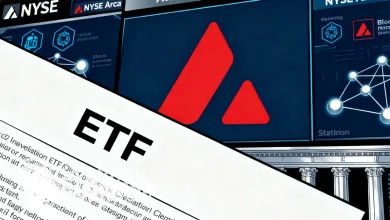Bitcoin Could Hit $190K as CZ Warns of Institutional Risks

- Tiger Research projects Bitcoin could reach $190K by Q3, driven by ETFs and retirement funds.
- Institutional adoption drives liquidity growth, but retail activity remains subdued in this cycle.
- CZ warns that tokenized assets and treasuries face risks that could test resilience in bear markets.
Bitcoin’s next chapter is being shaped by institutional money. Research firms see record inflows, while industry leaders caution about hidden risks. The market is growing with higher rates than previous market cycles, yet its long-term resilience remains uncertain.
Institutional Momentum Builds
Tiger Research estimates that Bitcoin would surge to $190,000 in the third quarter. The firm attributes the strongest drivers since 2021 to record liquidity, retirement fund access, and ETF demand. Its model begins with a base price of $135,000 and includes fundamentals and macro conditions multipliers to achieve the target.
The analysis highlights three main forces. First, the global M2 money supply is over $90 trillion, indicating record liquidity expansion. Second, institutional accumulation has grown to approximately 6% of the Bitcoin supply, anchored by ETFs and corporate treasuries. Third, President Trump’s executive order directs the DOL to reevaluate its guidance, potentially paving the way for 401(k) plans to include alternative assets.
Tiger Research says even a 1% allocation from the $8.9 trillion U.S. 401(k) pool would mean $90 billion in demand. That scenario would add structural depth to the market, similar to earlier breakthroughs with ETFs.
The shift is also seen in the trading patterns. Volumes are growing in fewer but larger transactions, in line with institutional block activity. Retail involvement has decreased, and institutions have become the primary source of liquidity.
Still, network activity tells a more cautious story. Daily transactions and active addresses remain below last year’s levels. Analysts note that retail engagement has not returned in full, suggesting reliance on big buyers alone.
On-chain signals echo the caution. The MVRV-Z score stands at a 2.49 level, which has led to correction in the previous cycles. Meanwhile, the adjusted spent output profit ratio indicates that sellers record small gains instead of extreme profits. Net Unrealized Profit/Loss is positive but far from euphoric. These measures are indicative of strength but not without weaknesses.
CZ Highlights Double-Edged Risks
At Bitcoin Asia in Hong Kong, Binance founder Changpeng Zhao framed the shift as both transformative and risky. He noted that public companies holding Bitcoin, alongside ETFs and new treasuries, mark a defining institutional breakthrough.
“In the world’s largest economy, 90% to 95% of the money is managed by institutions,” Zhao said. “Until ETFs and treasury companies, those guys couldn’t participate in crypto in a large way.”
Zhao highlighted how equity markets and crypto are converging. In his words, the industry is either bringing equity markets to crypto or bringing crypto to them. The two-way flow extends beyond Bitcoin treasuries. Real-world assets, such as treasury bills, real estate, and commodities, are being tokenized.
Related: CZ Eyes AI, DeFi, and RWAs Powering BNB Chain’s Next Growth Wave
Zhao termed this wave fantastic but pointed out the dangers. Billions flow into crypto by tokenized assets and corporate treasuries, but they face regulation, liquidity issues, and market cycle uncertainty. The most important test, he said, will occur in the next bear market.
“If treasuries can survive downturns, then the structure will prove resilient,” Zhao warned. Otherwise, the same institutions driving growth could amplify instability. His remarks highlighted the strife in the current market. On one hand, institutional adoption, retirement funds, and tokenization contribute to the growth of Bitcoin. On the other hand, its long-term stability will rely on whether these new pillars can withstand shocks.





